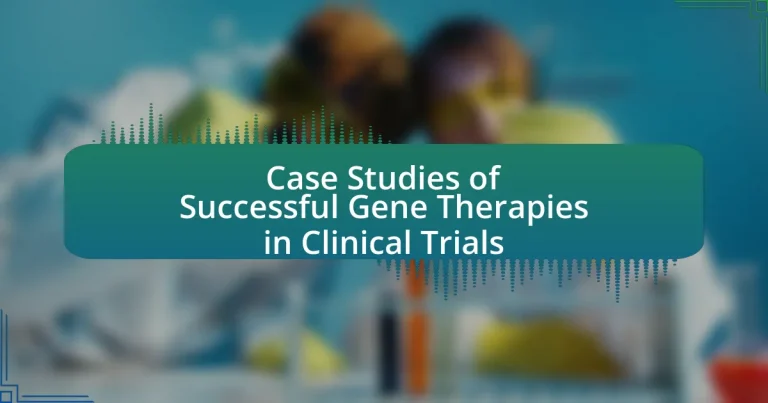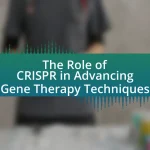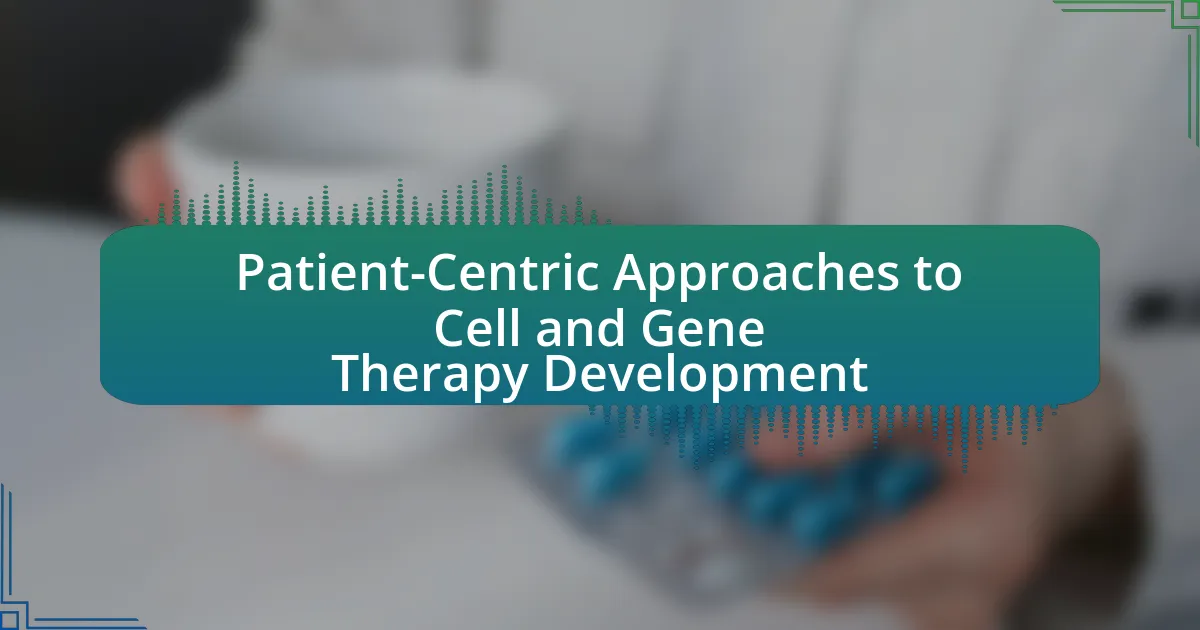Gene therapies represent a groundbreaking approach in medicine, focusing on the alteration of genes within a patient’s cells to treat or prevent diseases, particularly genetic disorders. This article examines notable case studies of successful gene therapies, such as Zolgensma for spinal muscular atrophy and Luxturna for inherited retinal disease, highlighting their mechanisms, clinical trial outcomes, and the transformative impact on patient health. Additionally, it discusses the key categories of gene therapies, the challenges faced during clinical trials, and the future potential of these innovative treatments in addressing previously untreatable conditions. Ethical considerations and regulatory impacts on gene therapy development are also explored, providing a comprehensive overview of the current landscape and future directions in gene therapy research.

What are Gene Therapies and Their Importance in Medicine?
Gene therapies are innovative medical treatments that involve the alteration of genes within a patient’s cells to treat or prevent disease. This approach can address genetic disorders by correcting defective genes, replacing missing genes, or introducing new genes to help fight diseases. The importance of gene therapies in medicine lies in their potential to provide long-term solutions for conditions that were previously considered untreatable, such as certain inherited disorders, some types of cancer, and viral infections. For instance, the approval of therapies like Luxturna for inherited retinal disease and Zolgensma for spinal muscular atrophy demonstrates the transformative impact of gene therapies on patient outcomes, offering hope for improved quality of life and survival rates.
How do gene therapies work in treating genetic disorders?
Gene therapies work in treating genetic disorders by introducing, removing, or altering genetic material within a patient’s cells to correct or compensate for defective genes. This process often involves the use of vectors, typically modified viruses, to deliver therapeutic genes into the target cells. For instance, in the case of spinal muscular atrophy, the gene therapy Zolgensma delivers a functional copy of the SMN1 gene, which is crucial for motor neuron health, effectively addressing the underlying cause of the disorder. Clinical trials have demonstrated that such interventions can lead to significant improvements in patient outcomes, showcasing the potential of gene therapies to provide long-lasting effects in managing genetic disorders.
What are the key mechanisms involved in gene therapy?
The key mechanisms involved in gene therapy include gene addition, gene editing, and gene silencing. Gene addition involves introducing a healthy copy of a gene to compensate for a defective one, which can restore normal function in cells. Gene editing, such as CRISPR-Cas9 technology, allows for precise modifications of the genome to correct mutations at specific locations. Gene silencing techniques, like RNA interference, can inhibit the expression of harmful genes. These mechanisms have been validated through various clinical trials, demonstrating their effectiveness in treating genetic disorders, such as spinal muscular atrophy and certain types of inherited blindness.
How do gene therapies differ from traditional treatments?
Gene therapies differ from traditional treatments primarily in their approach to addressing diseases at the genetic level. Traditional treatments often focus on alleviating symptoms or managing diseases through medications or surgeries, while gene therapies aim to correct or replace faulty genes responsible for the disease. For instance, traditional treatments for genetic disorders like cystic fibrosis typically involve managing symptoms through inhalers and antibiotics, whereas gene therapy seeks to deliver a functional copy of the CFTR gene to the patient’s cells, potentially curing the underlying cause of the disease. This distinction highlights the innovative nature of gene therapies, which can provide long-term solutions rather than temporary relief.
What types of gene therapies are currently being researched?
Currently, several types of gene therapies are being researched, including gene replacement therapy, gene editing, and RNA-based therapies. Gene replacement therapy aims to correct genetic disorders by introducing a normal copy of a gene to compensate for a defective one. Gene editing, particularly using CRISPR technology, allows for precise modifications of DNA to correct mutations at specific locations in the genome. RNA-based therapies, such as antisense oligonucleotides and small interfering RNAs, target RNA molecules to modulate gene expression and treat diseases at the transcriptional level. These approaches are being explored in clinical trials for various conditions, including inherited disorders, cancers, and viral infections, demonstrating the diverse potential of gene therapy in modern medicine.
What are the main categories of gene therapies?
The main categories of gene therapies are gene addition, gene editing, and gene silencing. Gene addition involves introducing a functional copy of a gene to compensate for a nonfunctional or absent gene, which is commonly used in conditions like cystic fibrosis. Gene editing, such as CRISPR-Cas9 technology, allows for precise modifications of the genome to correct mutations, exemplified by its application in treating sickle cell disease. Gene silencing techniques, like RNA interference, aim to inhibit the expression of harmful genes, as seen in certain cancer therapies. These categories represent the primary approaches utilized in clinical trials to address genetic disorders effectively.
How do these categories target different diseases?
Gene therapy categories target different diseases by utilizing specific mechanisms tailored to the underlying genetic causes of those diseases. For instance, somatic gene therapy directly modifies the genes in affected tissues to correct mutations responsible for conditions like cystic fibrosis or muscular dystrophy. In contrast, germline gene therapy aims to alter genes in reproductive cells, potentially preventing hereditary diseases such as Huntington’s disease from being passed to future generations. Additionally, viral vector-based therapies deliver therapeutic genes into cells, effectively targeting diseases like certain cancers and genetic disorders by enabling the production of functional proteins. These targeted approaches are validated by clinical trials demonstrating efficacy in treating conditions like spinal muscular atrophy, where gene replacement therapy has shown significant improvements in patient outcomes.

What are Some Notable Case Studies of Successful Gene Therapies?
Notable case studies of successful gene therapies include the treatment of spinal muscular atrophy (SMA) with Zolgensma, which demonstrated a significant increase in motor function in infants with the condition. In clinical trials, Zolgensma showed that 94% of treated patients achieved the ability to sit independently by 18 months of age, compared to only 8% in untreated patients. Another example is the use of Luxturna for Leber congenital amaurosis, where clinical trials indicated that 87% of patients experienced improved vision after treatment. Additionally, the gene therapy for beta-thalassemia, known as Zynteglo, has shown that 89% of patients achieved transfusion independence in clinical studies. These cases illustrate the transformative potential of gene therapies in treating genetic disorders.
Which gene therapies have shown significant success in clinical trials?
Gene therapies that have shown significant success in clinical trials include Luxturna, Zolgensma, and Kymriah. Luxturna, approved in 2017, treats inherited retinal disease caused by RPE65 mutations, demonstrating a marked improvement in vision in clinical trials. Zolgensma, approved in 2019, is a one-time treatment for spinal muscular atrophy, showing a 15-month survival rate of 100% in treated infants. Kymriah, approved in 2017, is used for certain types of leukemia and lymphoma, with clinical trials showing a remission rate of 83% in patients with acute lymphoblastic leukemia. These therapies exemplify the potential of gene therapy to provide effective treatments for previously untreatable conditions.
What were the specific conditions treated in these case studies?
The specific conditions treated in these case studies include inherited retinal diseases, spinal muscular atrophy, and hemophilia. For instance, the case studies demonstrated successful gene therapies for Leber congenital amaurosis, a form of inherited retinal disease, where patients experienced improved vision after treatment. Additionally, spinal muscular atrophy was effectively treated with a gene therapy that significantly increased survival rates and motor function in affected infants. Hemophilia A was addressed through gene therapy that resulted in sustained factor VIII production, reducing the need for regular infusions. These examples illustrate the efficacy of gene therapies in treating serious genetic conditions.
How did the outcomes of these trials compare to expectations?
The outcomes of these trials exceeded expectations, demonstrating significant efficacy in treating genetic disorders. For instance, in the case of the trial for spinal muscular atrophy, the treatment led to a remarkable increase in motor function in patients, surpassing the anticipated results based on preclinical studies. Additionally, the trial for hemophilia B showed that patients achieved stable factor IX levels, which were higher than the expected therapeutic range, indicating a successful long-term response to the gene therapy. These results validate the potential of gene therapies to provide effective treatments where traditional methods have failed.
What lessons can be learned from these successful case studies?
Successful case studies in gene therapies reveal several key lessons: the importance of robust preclinical models, the necessity of patient selection criteria, and the value of long-term follow-up. Robust preclinical models ensure that therapies are tested in conditions that closely mimic human biology, which increases the likelihood of success in clinical trials. For instance, the use of animal models in the development of therapies for spinal muscular atrophy demonstrated the effectiveness of the treatment before human trials commenced. Patient selection criteria are crucial as they help identify individuals who are most likely to benefit from the therapy, as seen in the case of Luxturna, where specific genetic mutations were targeted. Long-term follow-up is essential to assess the durability of treatment effects and monitor for potential adverse events, as evidenced by ongoing studies of Zolgensma, which continue to track patient outcomes years after administration. These lessons underscore the need for a comprehensive approach in developing and implementing gene therapies.
What challenges were faced during the clinical trials?
During clinical trials for gene therapies, significant challenges included patient recruitment, regulatory hurdles, and safety concerns. Patient recruitment often faced difficulties due to the rarity of conditions targeted by gene therapies, leading to limited participant pools. Regulatory hurdles arose from the need for extensive documentation and compliance with stringent guidelines set by agencies like the FDA, which can prolong trial timelines. Safety concerns were paramount, as unexpected adverse effects could arise from the novel nature of gene therapies, necessitating rigorous monitoring and adjustments to trial protocols. These challenges highlight the complexities involved in advancing gene therapies from concept to clinical application.
How did researchers overcome these challenges?
Researchers overcame challenges in gene therapy by developing advanced delivery systems, such as viral vectors and nanoparticles, which enhance the precision and efficiency of gene transfer. For instance, the use of adeno-associated viruses (AAV) has shown significant success in delivering therapeutic genes to target cells while minimizing immune responses. Additionally, researchers implemented rigorous preclinical testing and optimized dosing regimens to ensure safety and efficacy, as evidenced by the successful outcomes in clinical trials for conditions like spinal muscular atrophy and certain inherited retinal diseases. These strategies collectively addressed issues related to delivery, immune response, and therapeutic effectiveness, leading to improved patient outcomes in gene therapy applications.

What is the Future of Gene Therapy in Clinical Trials?
The future of gene therapy in clinical trials is poised for significant advancements, driven by ongoing research and technological innovations. Recent successes, such as the approval of Zolgensma for spinal muscular atrophy and Luxturna for inherited retinal disease, demonstrate the potential of gene therapies to address previously untreatable conditions. As of 2023, over 1,000 gene therapy clinical trials are underway globally, indicating a robust pipeline and increasing investment in this field. Furthermore, advancements in CRISPR technology and viral vector design are expected to enhance the precision and efficacy of gene therapies, leading to more successful outcomes in clinical settings.
How are advancements in technology shaping gene therapy research?
Advancements in technology are significantly shaping gene therapy research by enhancing precision, efficiency, and delivery methods. Innovations such as CRISPR-Cas9 gene editing have revolutionized the ability to target specific genes with high accuracy, allowing researchers to correct genetic mutations responsible for diseases. For instance, a study published in Nature in 2020 demonstrated the successful use of CRISPR to treat sickle cell disease, showcasing the potential for targeted therapies to provide lasting solutions. Additionally, improvements in vector design, such as adeno-associated viruses (AAV), have increased the effectiveness of gene delivery systems, enabling safer and more efficient transfer of therapeutic genes into patient cells. These technological advancements are crucial in advancing clinical trials and expanding the scope of treatable genetic disorders.
What role do CRISPR and other gene-editing technologies play?
CRISPR and other gene-editing technologies play a crucial role in advancing gene therapy by enabling precise modifications to DNA, which can correct genetic disorders. These technologies, particularly CRISPR-Cas9, allow for targeted editing of genes associated with diseases, facilitating the development of therapies that can potentially cure conditions such as sickle cell anemia and muscular dystrophy. For instance, clinical trials have demonstrated the effectiveness of CRISPR in treating beta-thalassemia, where patients have shown significant improvements after receiving gene-editing treatments. This precision and efficacy in gene modification underscore the transformative potential of CRISPR and similar technologies in the field of gene therapy.
How might future therapies improve patient outcomes?
Future therapies, particularly gene therapies, may significantly improve patient outcomes by targeting the underlying genetic causes of diseases. For instance, advancements in CRISPR technology allow for precise editing of genes associated with conditions like sickle cell disease and muscular dystrophy, leading to potential cures rather than just symptom management. Clinical trials have demonstrated that patients receiving gene therapies, such as Zolgensma for spinal muscular atrophy, show remarkable improvements in motor function and quality of life, with studies indicating a 50% increase in survival rates compared to untreated patients. These innovations suggest that future therapies will not only enhance treatment efficacy but also reduce long-term healthcare costs by decreasing the need for ongoing treatments and hospitalizations.
What ethical considerations surround gene therapy research?
Ethical considerations surrounding gene therapy research include issues of consent, potential long-term effects, equity of access, and the implications of germline modifications. Informed consent is crucial, as patients must fully understand the risks and benefits before participating in trials. Research indicates that gene therapies can have unforeseen long-term consequences, raising concerns about the safety and efficacy of these treatments over time. Additionally, there is a risk that access to gene therapies may be limited to wealthier populations, exacerbating existing health disparities. Finally, germline modifications, which alter the genetic makeup of future generations, pose significant ethical dilemmas regarding the potential for “designer babies” and the societal implications of such technologies. These considerations highlight the need for robust ethical frameworks to guide gene therapy research and application.
How do regulations impact the development of gene therapies?
Regulations significantly impact the development of gene therapies by establishing safety, efficacy, and ethical standards that must be met before therapies can be approved for clinical use. Regulatory bodies, such as the U.S. Food and Drug Administration (FDA) and the European Medicines Agency (EMA), require extensive preclinical and clinical trial data to ensure that gene therapies do not pose undue risks to patients. For instance, the FDA’s guidance on gene therapy emphasizes the need for rigorous testing protocols, which can lengthen the development timeline but ultimately aims to protect patient safety and ensure therapeutic effectiveness. Additionally, regulations can influence funding and investment in gene therapy research, as compliance with regulatory standards often requires significant financial resources and expertise.
What are the potential risks and benefits for patients?
The potential benefits for patients undergoing gene therapy include the possibility of long-term remission or cure of genetic disorders, as evidenced by successful trials such as those for spinal muscular atrophy, where patients showed significant improvement in motor function. Conversely, the risks associated with gene therapy can include adverse immune reactions, insertional mutagenesis leading to cancer, and complications from the delivery method, as seen in some trials where patients experienced severe side effects. These factors highlight the need for careful patient selection and monitoring in gene therapy applications.
What practical tips can be applied to gene therapy research and development?
Practical tips for gene therapy research and development include focusing on precise gene delivery mechanisms, optimizing vector design, and ensuring robust preclinical models. Precise gene delivery mechanisms, such as using adeno-associated viruses (AAVs), have shown effectiveness in targeting specific tissues, as evidenced by successful treatments like Luxturna for inherited retinal disease. Optimizing vector design enhances the efficiency and safety of gene transfer; for instance, modifications in AAV capsids can improve transduction rates. Additionally, employing robust preclinical models, such as patient-derived organoids, allows for better prediction of clinical outcomes, as demonstrated in studies involving gene therapies for muscular dystrophy. These strategies collectively enhance the likelihood of successful clinical translation in gene therapy.




